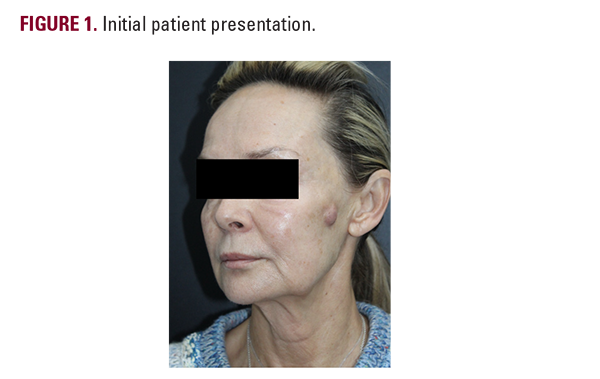Hypochlorous Acid for a Persistent Filler Nodule: A Case Report
September 2025 | Volume 24 | Issue 9 | 934 | Copyright © September 2025
Published online August 16, 2025
Nicholas Urbanski BSa, Kanthi Bommareddy MDb, Shino Bay Aguilera DOc
aDepartment of Dermatology, Herbert Wertheim College of Medicine, Florida International University, Miami, FL
bDepartment of Dermatology, Larkin Health System, South Miami, FL
cShino Bay Cosmetic Dermatology & Laser Institute in Fort Lauderdale, Fort Lauderdale, FL
Abstract
While noninflammatory nodules after hyaluronic acid (HA) filler injection are a relatively common phenomenon, delayed-onset nodules (DONs) are relatively uncommon and a significant complication of HA filler treatment. DONs can be inflammatory, granulomatous, or infectious. Infectious nodules are a significant concern for aesthetic providers due to the development of biofilms, and understanding the pathophysiology, diagnosis, and management of DONs is essential for clinicians to minimize risks and optimize patient outcomes. A sixty-year-old female presented to the clinic with a 3 cm hard, rope-like, indurated nodule with finger-like projections and purulent exudate on the left zygomatic cheek. She developed a firm, growing nodule, which was treated with hyaluronidase, intralesional fluorouracil, steroids, and antibiotics over multiple visits at an outside clinic. Steroid treatment resulted in attenuation of growth, but the nodule grew subsequently afterward. At our office, we added hypochlorous acid to the treatment plan over 3 clinic visits, resulting in the lesion decreasing in size significantly with no tenderness, swelling, or drainage. Biofilms are a therapeutic challenge because of their antibiotic resistance, unique biochemical milieu, and ability to evade the immune system. Hypochlorous acid is a safe and effective treatment for infections because of its broad-spectrum antimicrobial coverage and oxidative properties.
INTRODUCTION
Hyaluronic acid (HA) fillers are widely used in aesthetic medicine for facial rejuvenation, volumization, and wrinkle treatment. Noninflammatory nodules after HA filler injection are a relatively common phenomenon and a result of poor technique or a large volume bolus in one area.1 Unlike these nodules, delayed-onset nodules (DON) occur in 0.5% of injections and can be inflammatory, granulomatous, or infectious. They often present as firm, nodular masses with variable swelling and drainage.2 While relatively uncommon, DONs are a significant complication of HA filler treatment, and understanding the pathophysiology, diagnosis, and management of DONs is essential for clinicians to minimize risks and optimize patient outcomes.
Case Summary A sixty-year-old female presented to the clinic with a 3 cm hard, rope-like indurated nodule with finger-like projections and purulent exudate on the left zygomatic cheek (Figure 1). The patient had been injected with Skinvive™ at an outside medical

facility for facial rejuvenation of the cheeks two months prior. She developed a firm, growing nodule, which was treated with hyaluronidase on six separate occasions. She was also treated with a combination of intralesional fluorouracil, dexamethasone, and Kenalog as well as one course of doxycycline and three







